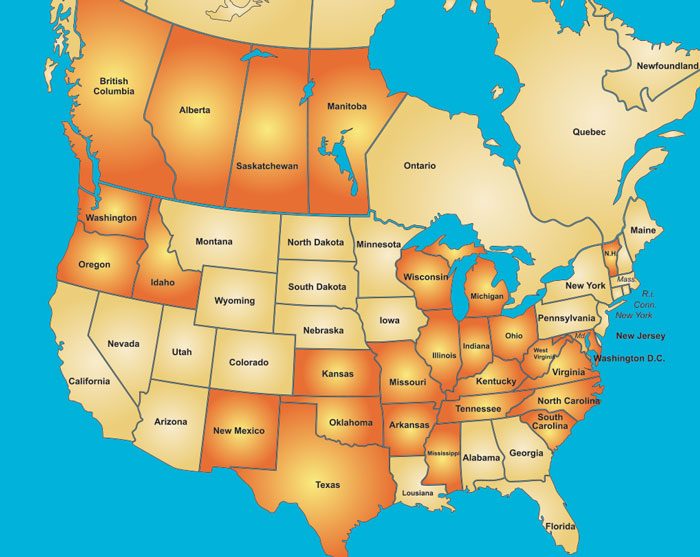The joint boards of the Equipment Dealers Assn. (EDA), the Midwest-SouthEastern Equipment Dealers Assn. (MSEDA), the United Equipment Dealers Assn. (UEDA) and the Western Equipment Dealers Assn. (WEDA) have voted to move forward with a proposal that would consolidate the four associations. This action is the first step toward consolidating, which requires a vote by dealer members of each association, which should be completed in spring 2022.
The consolidation effort was a dealer led process that started back in October 2018, says Tom Rosztoczy, president of Stotz Equipment and chair of the long-range planning group that oversaw the process.
Once the consolidation is completed, dealer members of the four associations will experience little to no change in their daily interactions with their association, with the goal to make the consolidation effective July 1, 2022, Rosztoczy says. The new organization will operate as the North American Equipment Dealers Assn. (NAEDA), returning to the national association’s original name. In 2015, NAEDA rebranded as the Equipment Dealers Assn. In 2017 Kim Rominger was named president/CEO of EDA, while still serving the same role for UEDA and linking a national and regional association together.
EDA has had financial challenges that date back to the previous NAEDA days before it had broken away from the regional associations and rebranded, Rosztoczy notes. When he became chairman of the EDA board in 2018, Rosztoczy says he shared his concerns with Rominger.
Long-Range Planning Committee
The dealers who were part of the long-range planning committee who oversaw the consolidation process included John Deere, Case IH, New Holland and Kubota locations. Dealers on the committee had varied in terms of number of stores as well.
- Tom Rosztoczy (Stotz Equipment – John Deere) Chair
- Ivan Dorhort (EDA Chair; Town & Country Implement – Case IH/NH/Kubota)
- Steve Hunt (H&R Agri-Power – Case IH)
- Joe Nash (Delta Group – Case IH)
- Jared Nobbe (Sydenstricker-Nobbe Partners – John Deere)
- Kevin Pawlowski (Farmer’s Equipment Co. – Case IH)
- Brian Streacker (Streacker Tractor Sales – NH/Kubota)
- Arthur Ward (Pattison – John Deere)
“We were struggling financially, and we had a sense of competition with the regional associations, which isn’t healthy. There’s got to be a better way to do this,” he says. “So, the EDA board decided to get the dealers in a room and see if the dealers can figure out a smarter way to do this.
“All regional equipment dealer associations were invited to participate and to contribute on how we can have a strong national association, while at the same time position our organization to address the changing needs of equipment dealers across North America,” he says.
Financial Stability
One of the most obvious benefits of the consolidation is financial stability, Rosztoczy and other dealers note. Merging into one organization will eliminate a number of duplicated costs and processes. For example, all 4 associations have to have audited financial statements. Having just one audited financial statement saves $100,000 a year, Rosztoczy says. By eliminating the regional associations involved, rented office space can be eliminated and regional executives can work out of their homes.
“If you just take the very simple, economic synergies that you create, it’s a meaningful number compared to EDA’s current financial situation,” he says.
Steve Hunt, vice president of H&R Agri-Power and a member of the long-range planning committee echoes this sentiment.
“It allows for reduction of overhead expenses so more resources are available to serve dealers in North America,” he says. “This provides a financially strong and sustainable association that will focus on federal and local legislation in a more fiscal and effective manner.”
Some associations and dealers not involved in the consolidation voiced concern that a single national association would not be able to give the attention to local and state legislative issues as well as the regional association could.
Art Ward of Pattison Ag says that as the dealer landscape changes, it is important for the associations to remain relevant. “Dealers continue to increase scale to be able to support their customers who are also getting larger. The dealer association is no different,” he says. “In order to support dealers, large and small, that operate in different states and provinces, the new larger association will be in a stronger position to identify the changing needs of the dealer members and have the resources to address those needs. This is what dealers expect from their association, and it is imperative the association grow and adapt to meet those needs.”
Dealers also note that the combined organization will be able to provide a greater level of service to its members. Jared Nobbe, Sydenstricker-Nobbe Partners, says, “The new combined NAEDA organization will provide a greater level of service by combining the strengths of each organization into one voice for the dealer.
“For example, our combined organization will have the ability to have a bigger and unified seat at the table on federal legislation issues while also building out additional resources for state and provincial governmental affairs. Additionally, we will be able to add new services such as financial, educational and merger & acquisitions to the dealer network. This new combined organization will be well positioned to help dealers through the ever changing dealer environment.”
The merger will also help secure a succession plan for association leadership down the road, notes Hunt. “The merger will utilize all talent from the associations merging for the benefit of all dealers in North America,” he says.
Rosztoczy agrees and says, “One of the benefits from a national association is, you know, we’ll have the 3 execs who run the 4 associations all staying with the merger. So, we’ll have plenty of strength from that perspective.”
Hunt also says the reorganized NAEDA will provide additional resources and staff to better enhance manufacturer relations for dealers and notes this to be one of the key points on the consolidation effort. In addition, it will provide resources for dealers that need assistance with dealership operations, training and efficiencies to become more profitable and sustainable, he says.
Dealer Benefits
Looking at the merger as a dealer, Ward says as dealerships continue to grow and do business in multiple states and provinces, their needs from the association change. A larger national association would have greater resources to support those needs.
“A larger national association will be better suited to support them across boundaries, particularly with government affairs,” he says. “The new association will be able to represent a larger group of dealers when dealing with manufacturer relations. It will also be able to provide a larger array of products and services that help dealers improve their business, regardless of their size.”
Hunt and Rosztoczy both note the merger will simplify dues schedules for dealers. There will be a common due structure across all states and provinces involved with the merger, Hunt says. Currently, national dues are handled two different ways and it varies by regional association, Rosztoczy says. Some regional associations are billing their membership for the combination of regional and national dues. However, for the associations that don’t do that, their dealers receive two bills.
“Those two structures will not change after the merger. If you’re a regional association that’s not involved in the merger, functionally, nothing changes for you other than hopefully you have a stronger national association that can support you when you need help,” he explains.
Stotz has stores that are currently in WEDA’s region as well as some that are in FWEDA’s region, but he says all of his locations will benefit from the merger. “More of my stores are in FarWest where we’re not part of the unification, but it doesn’t hurt me. If these associations get together as a dealer, it only increases the chances that my national association can get things done when I need them to,” Rosztoczy says.
The consolidated NAEDA will cover 24 states and 4 provinces and will have 3,000 dealer members, says John Schmeiser, CEO of WEDA. For the associations that opted out of the consolidation effort, the door to join isn’t closed, he says. The regional associations that opted out include:
- FarWest Equipment Dealers Assn.
- Iowa-Nebraska Equipment Dealers Assn.
- Pioneer Equipment Dealers Assn.
- Montana Equipment Dealers Assn.
- Northeastern Equipment Dealers Assn.
- Deep Southern Equipment Dealers Assn.
Mark Hennessy, president and CEO of the Iowa-Nebraska Dealers Assn., says it is important to their organization to have a strong national voice for dealers. However, at this point INEDA wants to see how the consolidation plays out.
A list of the U.S. equipment dealer associations’ most recently reported financial reports is available to Ag Equipment Intelligence subscribers here.
Related Content
Guest Blog: 5 Regional Dealer Associations Recommend Opposing Proposed EDA Merger
4 Equipment Dealer Associations Board of Directors Vote to Form New National Association







